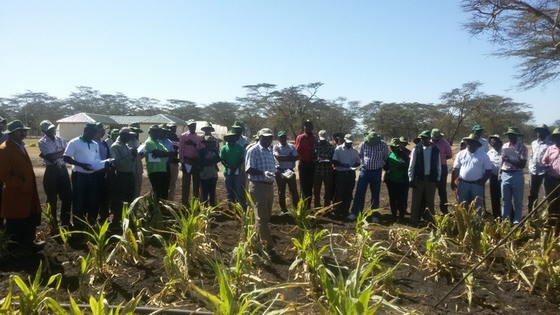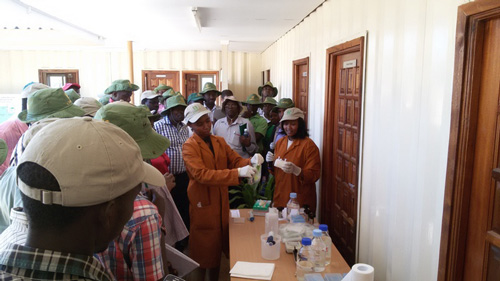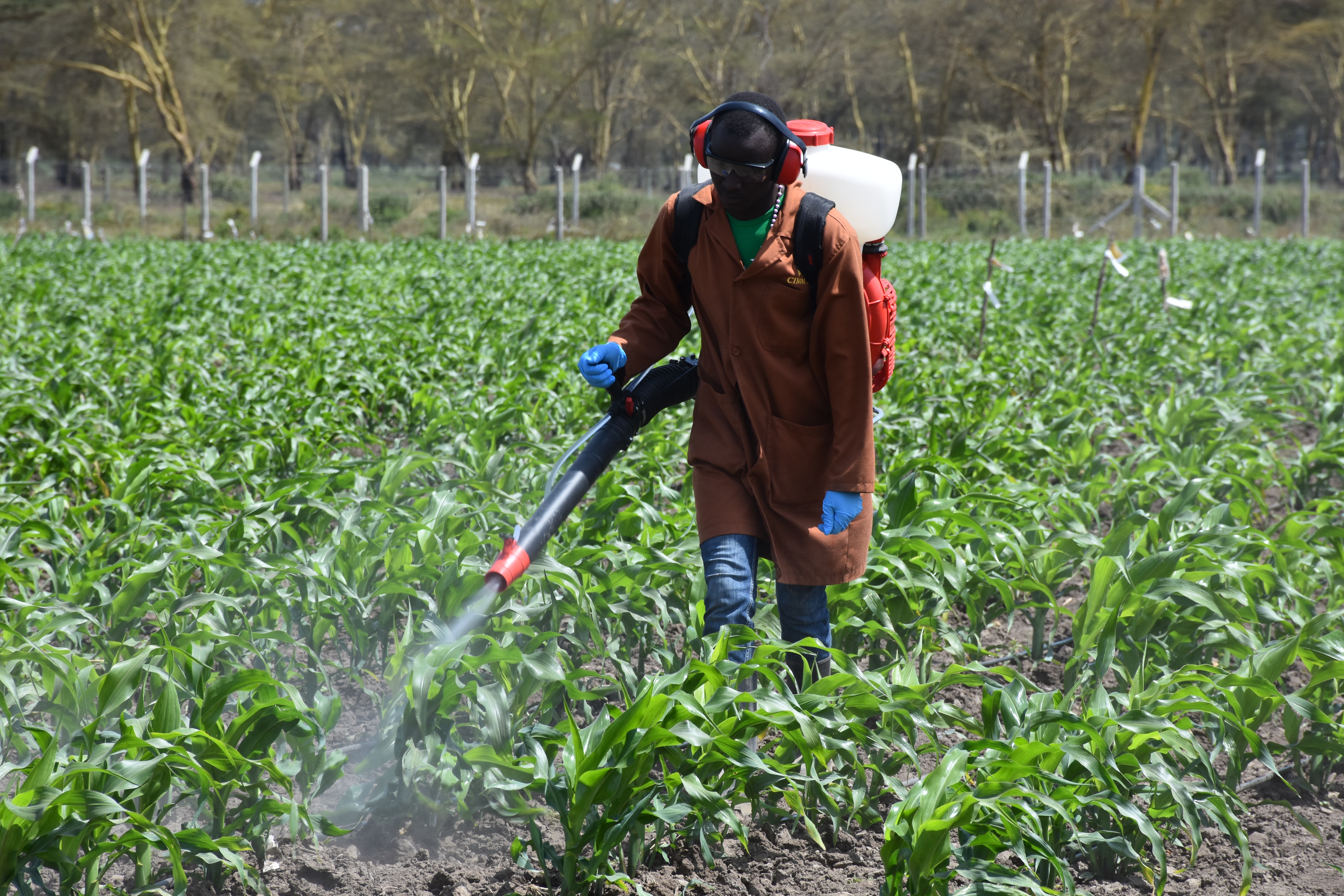
Maize lethal necrosis (MLN) has rapidly emerged as one of the deadliest maize diseases in eastern Africa capable of causing complete yield loss under heavy disease pressure. This means that Kenya and neighboring countries which largely depend on maize as their main staple food and source of income are on the verge of a looming food and economic crisis.
The disease is difficult to control for two reasons: firstly, it is caused by a combination of viruses; secondly, it can be spread through seed and by insect vectors that may be carried by wind over long distances. Affected crops suffer various symptoms such as severe stunting, tassel abnormality, small ears with poor seed set, chlorotic leaf mottling, leaf necrosis and premature plant death.
Much more than CIMMYT and East Africa
Sixty phytosanitary regulators and seed industry scientists from 11 countries in eastern and southern Africa attended an MLN diagnostics and screening workshop from March 17–19, 2015, in Naivasha, Kenya. The objective of the workshop was to train scientists on the latest MLN diagnostics and screening methods and to share knowledge on how to control the spread of MLN. Besides DR Congo, Ethiopia, Kenya, Rwanda and Tanzania where the disease has been reported, other participants were from South Sudan and southern Africa (Malawi, Mozambique, South Africa, Zambia and Zimbabwe) that have no confirmed cases of MLN, but where maize is an important crop.
CIMMYT organized the workshop in response to the high demand for development of appropriate diagnostics methods and harmonization of regional protocols. Hence, facilitation by agencies like the Food and Agricultural Organization provided a much-needed regional overview of the MLN threat, in addition to perspectives from the International Centre of Insect Physiology Ecology and the Kenya Plant Health Inspectorate Services (KEPHIS) on MLN insect vectors and diagnostics methods respectively.
The workshop was conducted at the MLN screening facility in Naivasha, the largest of its kind established in response to the MLN outbreak in eastern Africa in 2013. It supports countries in the sub-Saharan region to screen seeds under artificial inoculation. The facility is managed jointly by the Kenya Agricultural and Livestock Research Organization (KALRO) and CIMMYT, and was established with support from the Bill & Melinda Gates Foundation and the Sygenta Foundation for Sustainable Agriculture. Biswanath Das, a maize breeder at CIMMYT, noted that “the site has evaluated more than 20,000 accessions since its inception in 2013 from over 15 multinational and national seed companies and national research programs.” This, he added, “has become a primary resource in the fight against MLN regionally.”
Collective pre-emptive actions for prevention: seeds of hope
Participants received hands-on training to identify symptoms of MLN-causing viruses and how to score disease severity by screening germplasm at the site. For some participants, this was a first. “This is my first time to see an MLN-infected plant. Now I understand the impact of MLN on maize production and the need to set up a seed regulatory facility. South Sudan has no laboratory to test planting materials. My first step will be to talk to my counterparts in the ministry to set up one,” said Taban James, a regulator from the Ministry of Agriculture in South Sudan.

The tragic reality is that almost all commercial maize varieties in East Africa are highly susceptible to MLN, based on evaluations done at the screening facility. Therefore, stronger diagnostic and sampling capacity at common border-points was agreed to be a key step towards controlling inadvertent introduction of MLN through contaminated seeds. This was particularly important for participants from southern Africa countries who noted an urgent need for surveillance at seed import ports and border areas to contain the spread.
Currently, Kenya, Uganda and Zimbabwe are the only countries that require imported seed to be certified as free of MLN-causing viruses. KEPHIS and CIMMYT have worked closely to restrict movement of germplasm from Kenya to countries in East Africa with reported MLN cases. Seed production fields are inspected thrice by KEPHIS, in addition to analysis of final seed lots. Plans are underway for CIMMYT in collaboration with the ministries of agriculture in Mexico and Zimbabwe to establish quarantine sites to ease germplasm movement in and out of these countries. Speaking on KEPHIS’ role, Francis Mwatuni, the officer-in-charge of Plant Quarantine and Biosecurity Station said, “We ensure all seed fields are inspected and samples tested for MLN resistance including local and imported seed lots from seed companies, to ensure that farmers get MLN-free seeds.”
The latest trends and options for diagnostics on MLN-causing viruses were covered as well, giving participants hands-on training using ELISA diagnostics systems. They were also briefed on polymerase chain reaction based diagnostics and the latest lateral flow diagnostic kits that are under development that will enable researchers to obtain diagnostic results in the field in minutes.
What next for MLN?
The rapid multiplication of the disease coupled with uncertainties over its spread is the biggest hurdle that scientists and other stakeholders are grappling with. KALRO Chief Researcher, Anne Wangai, who played a key role in discovering the disease in Kenya in 2011 observes that “The uncertainties over the transmission of MLN is a worrying phenomenon that requires stakeholders to urgently find a control point to manage and ensure seeds being given to farmers are MLN-free.”
Breeding remains a key component in the search for long-term solution for MLN, and several milestones have been covered to develop MLN-resistant varieties in East Africa. “CIMMYT has developed five hybrids with good MLN tolerance under artificial inoculation, which have either been released or recommended for release in Kenya, Uganda and Tanzania. Thirteen hybrids are currently under national performance trials in the three countries,” noted Mosisa Regasa, a maize seed system specialist at CIMMYT. He further added that it is critical for the MLN-tolerant hybrids to also have other traits important to farmers, so farmers accept these new hybrids.
Open information sharing forums like the diagnostics workshop are an important step to raise awareness and seek solutions to manage the disease. Sharing best practice and lessons learnt in managing the disease are major steps towards curbing MLN. In pursuit of this end, a major international conference on MLN opens next week.
Links: Slides from the workshop | Workshop announcement |Open call for MLN screening – May 2015
 Capacity development
Capacity development 

